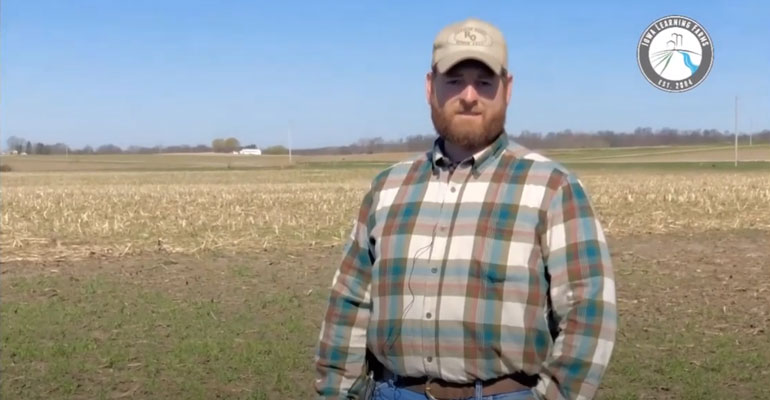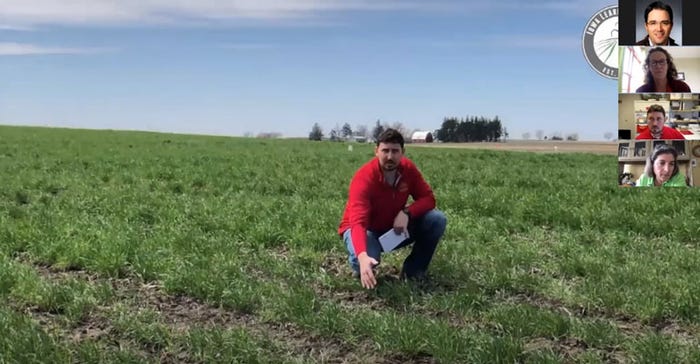May 11, 2020

With mandates and commonsense demanding social distancing and sometimes radical changes in how things get done, Iowa State University Extension’s Iowa Learning Farms has stayed true to its mission to deliver relevant and timely information and learning opportunities to Iowa’s farmers.
In April, ILF produced two virtual field days, both of which garnered solid attendance. With 160 live participants and an additional 150 archive views through the end of April, the audience for the presented material substantially exceeded a typical live field day.
The concept of a virtual field day is somewhat contradictory to traditional practice. Field days take place on the farm and in the field, not something one participates in from their favorite armchair. The different approach wasn’t perfect but was considered successful. In reviewing participant feedback and speaking with the presenters involved with the first two efforts, the ILF team noted some discomfort with the virtual format, some missing elements and also some advantages.
Attracting more viewers online
The ILF Virtual Field Days debuted April 16 with “Managing Cereal Rye Ahead of Corn.” The session featured Mark Licht, ISU Extension cropping systems specialist, and Alison Robertson, ISU Extension plant pathologist. Using a combination of prerecorded field video and live presentation of data from ISU research, the event elicited positive feedback from participants and drew over 100 viewers.
Wade Dooley, a sixth-generation Marshall County farmer, “hosted” the April 24 ILF Virtual Field Day from Glenwood Century Farm. While this was his first time hosting an ILF field day, he had hosted field days produced by Practical Farmers of Iowa previously and had attended numerous events at other farms. He also mentioned that field days conducted during busy seasons, such as planting and harvest, tend to be self-filtering.
“Farmers must make a business-based decision to take time out of their field to attend, so the topic must be very compelling to bring them during this time of year. However, one benefit of the virtual format is they can listen live or archived from the tractor without missing a beat in the field.
“I’ve driven 50 to 100 miles to attend field days to learn about interesting topics, which I felt could help me improve my farming business,” Dooley says. “With the virtual event, nobody did any driving but the ILF team and I, and the format allowed us to do some interesting things.”
Dooley says it’s not practical to ask participants attending an in-person field day to move to different parts of a farm during the event. “If you ask everybody to load up and caravan to more than two different spots, you lose a lot of time and they start falling off. With the virtual event, I was able to take the participants to four different fields on my farm instantaneously.”
The good, the bad and the tech
Beyond the obvious difference of not standing in a farm field, these first sessions brought to light some advantages and disadvantages of the virtual format. And a couple surprising similarities, such as technology issues:
Pros. A big plus for the virtual format is not having to worry about weather. There is no need for contingency plans or any last-minute scramble if a storm rolls in at just the wrong time.
Wind and weather, or simply the distance between the speaker and the group in the field can also make it difficult for the audience to hear all parts of the presentations when the event takes place on the farm. In the virtual format, all the speakers are easily heard.
The virtual event also makes the content accessible to a different mix of participants. The audience doesn’t need to travel to the site – or even be within driving distance – to join the field day. The format also makes it easy for people other than farmers to join and learn. Whether they are students, researchers, conservationists or someone interested in joining the profession, anyone can be a part of a virtual field day. The ability to download and listen at a later time also enables broader audience exposure.
Prerecording the field segments delivers some benefits as well. Beyond being able to avoid inclement weather, recording and editing the video segments helps the team efficiently deliver very focused information. Fine-tuning the segments to eliminate excess chatter while highlighting the planned messages provides more impactful information for participants in a compressed time frame. This enables delivery of a full diet of content in one hour rather than the two or more hours normally consumed by a field day.
Cons. Virtual participants lose out on the social aspects of field days. They aren’t able to renew old acquaintances or informally chat over coffee or a meal. The format also doesn’t allow for friendly banter and side conversations that are commonplace at a traditional field day. And questions and discussions initiated from the audience are less frequent.
This reluctance to ask questions may be related to discomfort with the technology aspects of the event or may arise from the loss of anonymity one might have as part of a large group. Individuals may also be uncomfortable because they don’t know who else is on the call, or who may have made a previous statement or posed a question. It’s all new territory and will take some getting used to.
The biggest sensory downside to the virtual event is missing out on the sounds, sights and smells of the farm. The format requires more description of what the audience could see if they were standing in the field. For example, in one of the video segments, Dooley pulled a cover crop turnip from the ground and described why he likes eating them in the fall. The participation dynamic is also quite different. A presenter can’t simply turn over a spade full of soil and invite the audience to observe and discuss what’s happening below the surface.
Tech challenges
It doesn’t seem to matter whether an event is held in a field or virtually, technology can present challenges. “I don’t believe I’ve ever been to a field day where there weren’t issues with microphones, speakers or some other piece of equipment,” Dooley says.
The ILF team also saw some jittery video stream issues, and users unfamiliar with their personal devices may have some difficulty with easily muting and unmuting to ask questions. Dooley also mentioned that internet access and available bandwidth to support the virtual format isn’t consistently available in some rural areas of the state.

TIMESAVER: Instead of driving to a field day, farmers can listen to a virtual presentation live or archived while in their tractor cab working in the field.

Iowa weather also challenges the technology. Wind noise is evident in the recording for the first ILF virtual event, but some quick research and changes in methodology by the ILF team resulted in extraordinary audio quality for the second field day.
While ILF has had significant success with its educational webinar programming, producing virtual field days on a relatively short timeline stretched the group’s collective imagination and know-how. Video recording, editing and video conference management skills were all tested and are being reviewed to enable continuous improvement.
New way to reach audience
According to Jacqueline Comito, ILF director, inclusion of virtual field days going forward as a part of ILF’s comprehensive outreach and education programming is not out of the question. “ILF is still learning and working out the kinks to maximize the benefits of virtual field days, but we are already seeing some excellent feedback. We do understand this format is not going to appeal to everyone, but it could be a powerful way to reach new audience members and constituencies.”
ILF plans to resume traditional field days as soon as possible and is also looking to use direct mail campaigns to get the latest in research findings and best practices into the hands of Iowa’s farmers.
To view the archived virtual field days or join future ILF events, visit ILF Events. Direct links to the first two virtual field days are April 16, Managing Cereal Rye Ahead of Corn and April 24, Farming for the Future with Wade Dooley.
Ripley is an Iowa Learning Farms conservation outreach specialist.
About the Author(s)
You May Also Like




